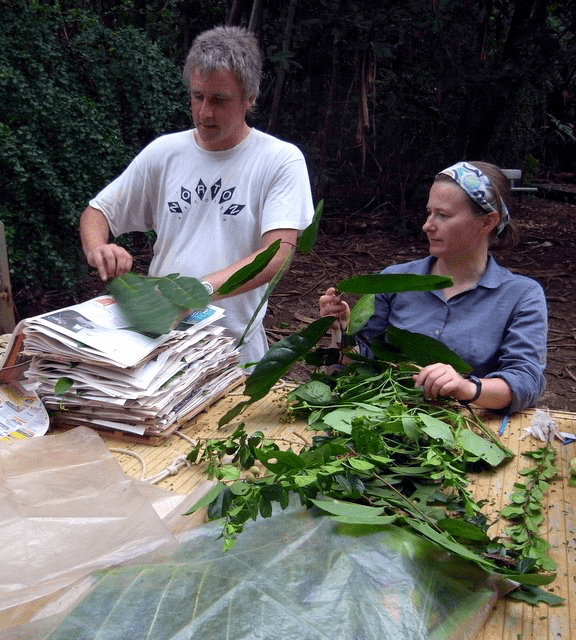The Curator of the Australian National Herbarium is using plant specimens collected via TERN AusPlots’ national environmental monitoring to supplement and compliment Australia’s biological collections—key resources for many environmental applications including tracking climate and human induced change.
Arid rangelands, temperate woodlands, alpine heathlands, tropical rainforests—the Australian National Herbarium (ANH) has plant specimens from all these unique Australian environments and more. By collecting specimens from all our ecosystems a physical record of plant distribution in time and space is created.
Thanks to TERN’s plot-based ecosystem monitoring program, AusPlots, plant samples from some of Australia’s most remote arid ecosystems are filling important gaps in the ANH’s collection. Over the past 12 to 18 months around 300 plant specimens collected by AusPlots have been added to the National Herbarium.
 |
| Australian National Herbarium (ANH) Curator, Brendan Lepschi, collecting plants on Christmas Island with ANH colleague Bronwyn Collins (photo courtesy of Murray Fagg) |
 |
| AusPlots collect vegetation samples during their surveying of Australia’s rangelands, barcodes the specimens for the AusPlots database, then prepare them for lodgement in herbaria across Australia. |
Brendan Lepschi, Curator of the ANH, says that the AusPlots specimens are a significant and valuable addition to the herbarium.
“Quite apart from the fact that it allows us to further develop the collections of the Australian National Herbarium, the material is important because it is frequently from areas that are not well collected botanically, and has excellent, high-quality metadata,” says Brendan.
“Additionally, all material has been identified by skilled botanists familiar with the vegetation of the particular area from which the material was collected, which means that identifications are robust and reliable.”
“The beauty of the AusPlots samples is that everything is vouchered, meaning that we get specimens of a greater proportion of the flora than if we were receiving material from targeted taxonomic collecting. That is not to say that taxonomic or herbarium collecting is of lesser value, it’s just a different approach and the mix of material will be different as a result. AusPlots complements the collecting undertaken by herbarium botanists, through focusing on vegetation communities and landforms rather than taxonomic groupings,” says Brendan.
Herbarium collections are important for taxonomic research, floristic studies, and systematic research such as the evolution and diversification of different plant groups.
In addition, the records contained in herbaria can be used to monitor changes to our environment over time, such as plant extinctions and human or climate induced changes in species and where they occur.
“Herbaria hold enormous amounts of data relating to the occurrence and distribution of plants in both time and space,” says Brendan. “Collectively, material in Australian herbarium collections dates back to the earliest days of European exploration of the continent, right up to the present day, and contain records of plant occurrences in areas that have since been completely modified by human activity.”
Using herbarium data, environmental scientists can track changes in our ecosystems and plot these against changes in human activities, climate, and land management policies. Doing so we can understand the impacts of human induced change and, in turn, use this information to develop more appropriate management policies and climate change mitigation and adaptation strategies.
Herbarium collections are a great resource for those examining spatial and temporal environmental change, but Brendan says that researchers need to be careful when applying herbarium data to environmental change studies.
“The absence of a species or taxon from a particular location in a particular time frame does not necessarily mean it did not or does not occur there. It may just be the case that no herbarium specimens exist,” warns Brendan.
The ANH currently has around 1.2 million plant specimens from all over Australia and the world. Whilst the AusPlots samples may seem like a drop in the ocean in terms of quantity, it’s their quality and ability to fill information gaps that makes them invaluable additions to Australia’s national biological collections.
“Overall, the material from TERN AusPlots provides a valuable addition to not only the ANH, but Australia’s national biological collections as a whole, and I look forward to receiving more material in due course!”
Published in TERN newsletter April 2015






